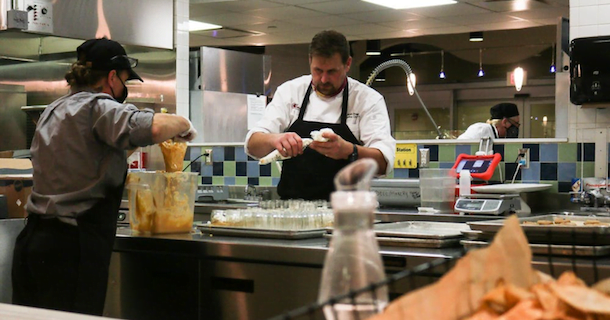
University officials have planned and often improvised their way through the pandemic and the many challenges brought about by the virus. The ongoing labor shortage remains one of the most persistent — and costly — challenges in higher education, one that university and campus card, dining, and auxiliary service professionals are all racing to solve.
In a recent webinar for the National Association of Campus Card Users (NACCU), two leaders from campus technology provider CBORD detailed how that labor shortage is hurting schools, and how leaders in higher education — along with their tech partners — are finding new ways to deal with the problem, reduce costs, and please students, staff and faculty.
In short, the latest technology around kiosks, biometrics and associated tools can help officials in higher education navigate the labor challenge and come out ahead.
“Labor is a huge portion of campus dining,” says Brett Africk, director of sales at CBORD, during that presentation entitled “From Staff to Supplies: Automation and Technology Solutions to Combat Shortages.” In fact, he says, labor “makes up typically the largest expense of campus dining.”
And that’s a major problem even as colleges and universities continue to have trouble attracting and hiring as many human workers as they were able to just a few years ago.
Statistics and anecdotes help tell a part of the labor shortage story.
An April report from the Chronicle of Higher Education found that even though the campus labor shortage has eased, there still remains a deficit of some 40,000 jobs, with dining services among the hardest-hit areas even as students have returned to in-person campus life.
And data shared during the webinar by Read Winkelman, vice president of sales at CBORD, also illustrate the situation on the ground, with some major schools having hundreds of part-time vacancies for those dining hall and other vital campus service jobs, he says. That goes along with dining hall hours that are still limited compared with pre-pandemic times and supply chain issues that still vex so many parts of the global economy.
As Africk put it, “staffing is always an issue. It was just amplified during the pandemic.”
But while campus technology partners and providers can’t do much directly about the staffing, they can do something about the shortage and the cost of all that suddenly scarce labor.
The technological benefits and growing mass appeal of kiosks and other evolving dining hall technologies are pretty well known by now. But the impacts that campus technology can have during this labor shortage — and can have in combination with a cutting-edge card, mobile or biometric ID program — are just beginning to emerge as college and university officials seek budget-friendly ways to keep vital amenities going.
Africk dug into the numbers to make his case.
He says a higher education organization using a human cashier would very likely have to pay at least $36,000 annually for that worker for a full academic year that includes fall and spring semesters.
That cost rises significantly if that worker earns benefits or is part of a union. Indeed, the nationwide labor shortage likely has driven even that basic cost higher, he says, as pay has generally increased for such jobs.
A single kiosk, by contrast, might cost between $25,000 and $30,000, with those costs lowering with more deployments. “Your ROI on a kiosk is less than a year,” explains Africk.
“You really need to compare it to the cost of labor you are trying to replace,” he says of dining hall technology, usually used with campus ID cards or mobile payment accounts or even biometrics.
But there is even more cost-benefit and return-on-investment potential when it comes to kiosks and similar automated tools in on campus, according to Africk and Winkelman.
Kiosks offer speed, increased order accuracy and upselling opportunities, all of them cost-savers and potential revenue-enhancers on their own, especially in this era of campus labor scarcity.
Take the example of a burger fan who is open to making that meal a truly deluxe experience – and who is offered that chance via the type of automated- and self-ordering software often found with the latest kiosks.
“It costs $1.50 or $1.99 to add a fried egg to a burger,” Africk offered as an example of that campus dining hall experience via the POV of a customer. “But that egg only costs you about 15 cents.”
Sure, human workers can certainly upsell, but in a crowded, busy campus environment — even one that might be untouched by labor shortages — such a job can be taxing and inconsistent when compared to a kiosk.
Upselling, though, might stand as a relative side benefit when compared to the labor-saving and cost-reduction potential of campus biometrics. That holds especially true for dining halls and other busy places such as libraries and recreational centers.
After all, Africk says, biometric ID “moves lines faster, and is a new way to solve the labor problem.” One doesn’t need to get rid of all human cashiers with biometrics, he pointed out, but a robust, well-integrated biometric system on campus can free those workers for other tasks, such as cleaning tables and restocking silverware.
That can provide further savings on labor costs. Winkelman, in fact, sounded a note of extreme optimism about the future of campus biometrics when he described a recent visit to Vanderbilt University in Nashville.
At Vandy, officials use facial recognition to identify students for certain tasks, a process customized for the university via the inclusion of the Vanderbilt “anchor down” phrase used for athletics.
Biometrics is clearly a bigger part of the campus future, especially as officials deal with the labor shortage and changing patterns of work. Kiosks and other technology also promise to help higher education leaders find new ways to reduce costs while also fulfilling their missions.
There’s also an added bonus, according to Winkelman, one that could serve to encourage even more use of all this software and hardware.
“Generation Z is used to this technology,” he says. “They are really fast, they are smart, and they pick up things incredibly fast.”




